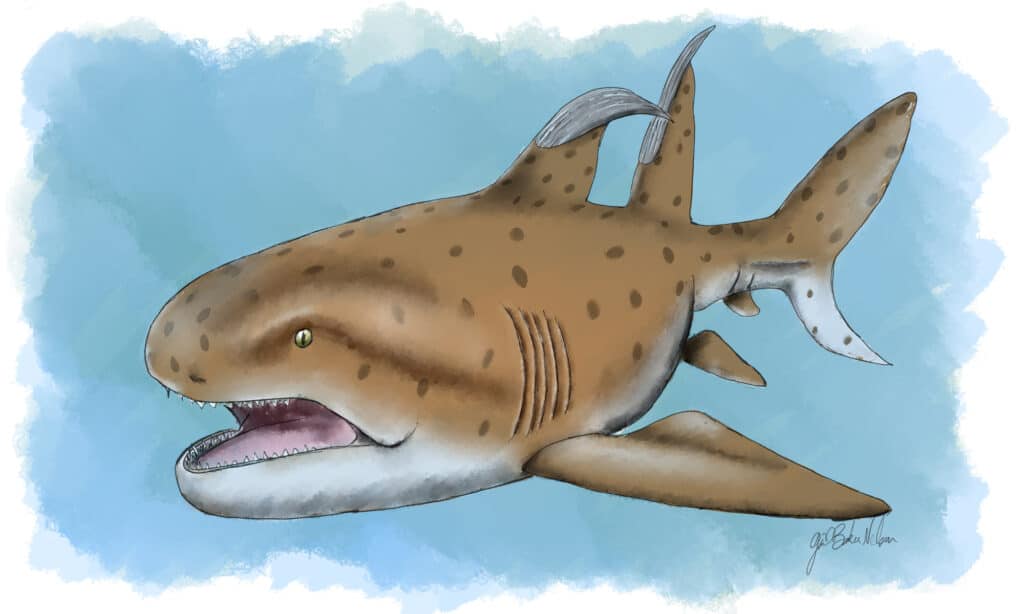The Hoffman’s Dragon Shark (Dracopristis hoffmanorum) is an extinct species of shark that lived during the Carboniferous period about 307 million years ago. The fossil of this prehistoric shark was discovered in New Mexico in 2013, and the first full description was published in 2021. When the 6.7-foot-long shark was found in a formation, its unique dentition and powerful jaws caught the attention of the scientists right away. We now know that the Godzilla shark, as it was commonly called, belonged to a separate group of sharks known as ctenacanthiformes, which are different from present-day true sharks. Here are three interesting facts to know about the dragon shark.
It Took 7 Years of Study and Excavation to Describe and Name This Shark
John-Paul Hodnett, a graduate student at the time, discovered the first fossil of the Dragon shark in an area east of Albuquerque, New Mexico, back in 2013. However, it wasn’t until 2021 that it was fully excavated, studied, and formally named.
The species did get a nickname right away. It was called the “Dragon shark” or “Godzilla shark” because it had features that were similar to the Kaiju Godzilla from Japanese fiction movies. It also looked like a reptile in some respects.
Hodnett, who discovered the fossil, worked as the lead paleontologist of the dig and subsequent study on it. He worked with colleagues from the New Mexico Museum, North Arizona University, Pennsylvania’s St. Joseph’s University, and Idaho State University.
After years of study, scientists identified the fossil specimen, which the study was based on, as that of an adult female. It was a well-preserved skeleton with up to 90% of the original bones preserved. This fossil represents the most complete specimen in the ctenacanthiform family on record.
It took seven years to complete the study and publish a paper on this ancient fish. At some point during the excavation, 12 rows of teeth from the low jaws of this shark were obscured by layers of sediments. The scientists were only able to see and observe them using an angled light technique that illuminated them.
They Were Not True Sharks
Like present-day sharks, the dragon shark belonged to the class Chondrichthyes. They also belonged to the same subclass, Elasmobranchii, which means they’re closely related. However, the dragon shark was not a true shark. Instead, it belonged to a separate order of Chondrichthyes known as the Ctenacathiformes.
This shark family evolved separately from the true sharks about 390 million years ago. One of the major features that distinguished this shark from modern sharks is the size and nature of its jaws. The Ctenacanths generally had larger but less flexible jaws compared to present-day sharks.
The shark’s jaw is also the main reason why it was nicknamed the Godzilla Shark. It had a jawline similar to that of a dragon as well as fin spines that looked like that of the Kaiju Godzilla. The teeth of the 300-million-year-old shark looked nothing like that of present-day sharks. Instead of the spear-like rows of teeth you would see in today’s shark, theirs were shorter and squatter. They were about .79 inches long.
Although they were still ferocious predators, the nature of their teeth indicates that they hunted prey slightly differently. Instead of taking a massive bite out of prey like a great white would, their teeth were better adapted for grasping and crushing prey.
Scientists believe Hoffman’s Dragon Shark would have been an ambush predator. They came to this conclusion based on the shape of the teeth and the fins, which suggests that this fish lurked at the bottom of the ocean, probably waiting for prey. It hunted small fish and crustaceans.
Interestingly, this massive fish was not the apex predator in its habitat. Scientists found fossils of a larger prehistoric fish of the same family in the same location. The Glikmanius occidentalis, which was a much larger ctenacanth, would have been able to prey on this prehistoric shark.

Named After Ralph and Jeanette Hoffman
The common name “Hoffman’s Dragon Shark” is a direct translation of the official scientific name Dracopristis hoffmanorum. The specific name “hoffmanorum” pays homage to the New Mexico family that owns the lands of the Manzano Mountains where Hodnett first discovered the fossil. The genus name is a reference to the first moniker people gave the fossil when paleontologists first found it: dragon shark.
Scientists say the area where they found the fossil was quite unique. In fact, many have nicknamed it a fossil mining ground. There have been several fossil discoveries in this area apart from that of the Hoffman’s dragon shark. Paleontologists have uncovered the bones of several prehistoric animals, including numerous dinosaur bones in the high desert plateaus of New Mexico. That includes the Tyrannosaurus rex that lived in this area millions of years ago.
Back then, the area was a tropical rainforest, and a prehistoric seaway covered most of eastern New Mexico, extending into most of North America. According to the team that studied the dragon shark, this creature probably lived in shallow depths along the coast. Some other ancient fish species that lived alongside the dragon shark include hybodontiforms, Holocephalans and actinopterygians. The megalichthyoform sarcopterygian and several other fish species may have lived in this area as well.
Up Next
Thank you for reading! Have some feedback for us? Contact the AZ Animals editorial team.








